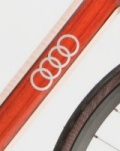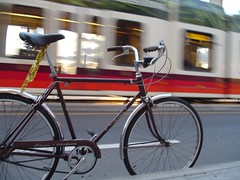This guest post is by Michael Andersen of Portland Afoot, a “10-minute newsmagazine” and wiki about low-car life in Portland.
A big strategy shift was in the air at this year’s Oregon Active Transportation Summit, the two-day conference and lobbying blitz that was, until 2011, known as the Oregon Bike Summit. Woven through the lectures and panels was a new bit of gospel: That bike and transit advocates need to work together. That they’ll get more done if they team up.
The umbrella they should share, believers say: “active transportation.” “Active transportation” includes riding the MAX? You’d better believe it, said BTA Executive Director Rob Sadowsky.
“If we put transit over here,” Sadowsky said, waving a hand, “and say that that’s not ‘active transportation,’ I personally believe that we will fail in our efforts. … Without them, we are much weaker, and with them we are very strong.”
Personally, I love public transit even more than I love bikes. But what if Sadowsky’s wrong?
First, I’m going to run off three reasons he might be. Then I’ll post three reasons he might be right. Finally, I’ll step aside and post some of the smartest things I heard people say on this topic over the last two days.
Here’s the case against a bike-transit alliance:
- To the public, “active transportation” is an abstract and passionless idea.
Here’s the secret weapon of bicycle politics: they involve bicycling, which happens to be a hoot. Hundreds of thousands of Oregonians intuitively grasp that bicycling should keep getting more awesome, and they put their hearts, votes and voices behind it. Multi-modal transportation networks may be good for the heart, but they don’t stir it.
- Bicycle dollars go much, much farther than public transit dollars.
Check out these comparisons, based on City of Portland data. (They’re not perfect, since they exclude suburban commuters and local spending, but they show how much faster bicycling has been growing, and how amazingly little this has cost us.) When your strongest political argument is thrift, you don’t invite a big spender to join your team.
- When push comes to shove, public transportation people are bigger and tougher and not to be trusted.
In January, scrambling to find the last 1 percent of its budget for the new “Orange” MAX line to inner southeast, TriMet made an unexpected grab for bike advocates’ lunch money: $18 million in state flexible funds that are often crucial for bike and pedestrian projects. TriMet argued, accurately, that the single biggest expense of the new rail line will be a new car-free bridge that will be a huge boon to foot and bike transportation, but bicycle advocates balked, eventually staving back most of TriMet’s request.
Now, here’s the case for an alliance:
- A better transit system means a better bike system, and vice versa.
This is obvious and unarguable. A bike is the perfect way to solve what public transit people call the “last mile” problem — getting from home to a frequent-service stop. Public transit, meanwhile, is the perfect way to solve what bike people call the “Christ, I’m not going to pedal all the way out there” problem.
- Public transit is much more “active” than you think.
Our intuition that riding a bike is a workout, while walking to the MAX station is negligible, is 10 years out of date. Recent science shows that many small bits of activity through the day add up to huge health benefits — my favorite study found that light rail commuters were 81 percent less likely than other commuters to become obese. If health is part of your reason for loving bikes, it’s a reason you should love trains and buses, too.
- Transit people are money experts.
It’s not just that transit agencies, unions and contractors have a herd of lobbyists who are nice to have on your side. It’s that those lobbyists are more experienced, better-paid and — especially in Portland — more successful at pulling in huge federal grants for active transportation projects.
Which case do you buy? Either way, check out these perspectives from some of Oregon’s sharpest active transportation thinkers.
—
Sami Fournier, bicycle instructor, Element Exercise in Bend: Backing public transportation makes bicycle advocates seem anti-car and negative.

“Cyclists have a simple, pure message: We need to ride more, and we need to ride more safely. … When you look at really big expensive investments for transortaiton, you take away from the beautiful, simple purity of that. (On collaborating with transit advocates) I’m convinced that it’s worth my time. But as a grassroots movement, it’s hard to organize people around this principle.”
Colin Maher, bicycle coordinator, TriMet: It’s easier to sell the public on a big transit project with bike improvements than a big bike project.

“80 percent of TriMet riders walk or bike. It is also an opportunity to reach a much wider audience: 81 percent of residents in the Portland region ride TriMet to some degree. … More people can relate to a transit project story than can relate to a bike project story.”
Gerik Kransky, advocacy director, Bicycle Transportation Alliance: We need all the help we can get against the auto lobby.

“Transit has a bigger bullhorn than bicycling does, but in the general scheme of things, both are a pipsqueak. … We’re going to do better by changing the funding environment as a team.”
Chris Smith, planning commissioner, City of Portland: It’s good to have friends who know where the money is.
“Bicycles are under-funded for their benefit. If you look at cost-benefit ratio, you should be putting massively more money for bicycles. (But) all the people who have figured out how to shake the transportation money tree are either in the auto camp or the transit camp. … If I’m a bicycle planner, I would want to cozy up to those transit planners and figure out how they shook the tree.”
(See also Smith’s own post on this topic.)
Roger Geller, bicycle coordinator, City of Portland: TriMet and the city keep getting better at designing bike-friendly transit.
“Every project, we’re missing opportunities in terms of building world-class design, but we’re learning all along. [If we were building the Yellow Line today] it probably would have had cycletracks on Interestate Ave, really good connections out to the peninsula on Portland Avenue… and would have probably included a really good bike parking structure at Rosa Parks.”
Steve Bozzone, board member, Willamette Pedestrian Coalition: Political reciprocity gets things done.

“If walking advocates, transit advocates, cycling advocates, skateboard advocates, all work together, then we protect each other and hence we’re stronger. … I’m thinking of the Idaho stop law last year and how that didn’t pass. The way things are working this year is we’re really pushing things that are good for bicycles and pedestrians, with the vulnerable road user bill and the crosswalk safety bill. If we were just pushing it as cycling advocates, maybe we wouldn’t even be talking about the crosswalk bill right now.”
Noelle Dobson, project director, Oregon Public Health Institute: Public transportation is active transportation.

“The research does show that it’s a very viable way to get more physical activity, and people with access to transit are more likely to get physical activity. If you’re going to walk a half an hour to the bus stop vs a 5-minute bike ride, you end up getting more physical activity getting transit.”
Scott Lieuallen, local supervolunteer: There’s nothing elected officials hate more than their supporters fighting among each other.

“There is a lot of political correctness to this thing. … They’re even trying to make allies of the freight guys. … I think it’s a way to make it more palatable to the electeds.”
Lake McTighe, active transportation project manager, Metro: If bike and pedestrian advocates believe in a partnership, transit advocates will come around.

“I would like to see transit be more of an advocate for bike and ped, and we need bike and ped advocates to make that happen.” TriMet will be a better ally “when they really understand that a strong biking and pedestrian infrastructure will get them a lot more riders.”
The cover story of Portland Afoot’s April issue is about Portland employers with the best low-car commuting benefits. BikePortland readers in the metro area can subscribe for $10 a year with coupon code “bikeportland.” Email Michael at michael@portlandafoot.org.




